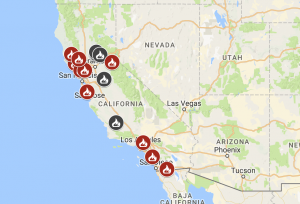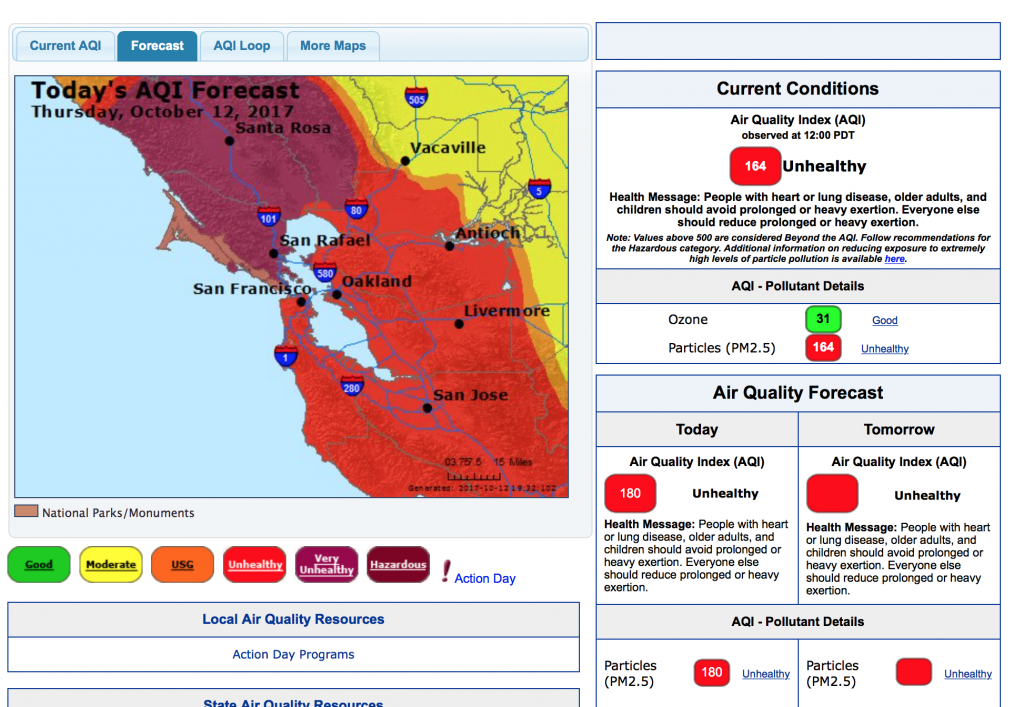Breathable air and clean water – things that many people take for granted.
Until you DON’T have them.
We’ve all been inundated with images, videos, and stories of people affected by the recent plethora of natural disasters. Harvey, Irma, Maria…. wildfires across an incredible amount of the western and northern US and Canada…earthquakes in Italy and Mexico.

Current California wildfires burning as of 2pm PST Sat Oct 21, 2017.
If we’ve been lucky enough to escape these events personally, we all know friends or family affected directly.
Inevitably this makes us think about our own family, and what we would do in those situations ourselves.
Yet when it comes to preparedness….many don’t think about it until it’s already happening to them.
Clean air and water is vital ALL the time, not just in a crisis
If you’ve been hanging around me or my social media for a while, you know that I teach about various aspects of healthy living. Having pure, clean, uncontaminated water to drink every day is important to our health – and that of our family. Equally as important is breathing clean, unpolluted air.
But this becomes even more so when afflicted with a natural disaster.
I know when Irma was heading right towards my parents’ home in Florida, and they chose to stay in their home, I was comforted knowing that should the worst happen, that they had access to pure, clean drinking water no matter how long they would be without. They didn’t have to worry if the stores would sell out of bottled water (they did), they didn’t have to worry about when the power would come on, they didn’t have to worry that the ATMs and debit card systems wouldn’t be working due to power outages.
These things are part of my family’s day-to-day healthy living routine – but especially important when you are facing these challenges.
I knew that if their neighborhood flooded (as it was predicted it might) that they could drink water from the nastiest of the nasty – for weeks.
One month after Maria, the people of Puerto Rico are dealing with their surroundings “rotting” from all the damage – and all that bacteria, feces and urine are impacting their water supply. Never mind that bottled water is still extremely hard to come by.
Wildfires and clean air
For years, I have taught about the dangers of indoor air pollution, and how it can be up to 100 times more toxic than outdoor air. It’s the reason the World Health Organization considers indoor air pollution the greatest environmental health threat to humanity.

For days following the recent Santa Rosa wildfires, the entire San Francisco Bay area was under dangerous air quality warnings.
Yet because when there isn’t an imminent obvious threat, people can ignore this vital strategy.
But when the fires are blazing outside…..the conversation turns towards mitigating the immediate threat. The fires can erupt in an instant, and don’t leave you much time to prepare.
Anyone who has ever been close to a wildfire – knows that awful stench of the smoke – and the orange haze over the sun. Having grown up on the east coast, we thankfully never had to face this type of natural disaster growing up.
Yet having spent the last almost 20 years on this west coast, it’s become all too familiar.
Three weeks ago, I walked outside and immediately smelled that unforgettable smell….and thought “There’s fire somewhere.” Sure enough, I went on the computer when I got home and searched CA fires, and there was one blazing in Anaheim, about 90 minutes north of me. Yet it was nowhere on the news. Not long after that, the Santa Rosa fires broke out.
And again I am reminded that I’m grateful I’m prepared.
HEPA filters are not enough
The overwhelming majority of air filters on the market are considered HEPA. These are meant to remove the particulates in the air. Dust, pet dander, pollen, dust mites, car and smoke fumes.
Yet what about the dangerous gases that are released into the air from forest fires, that are NOT cleaned out with a HEPA filter?
What happens when plastic burns? Or your cleaning products? How about clothing, PVC pipes, televisions, mattresses, insulation, particle board, paint, just to name a few?
Within the next 2 days, we are forecasted to again have close to 100 degrees and Santa Ana winds. Prime time for wildfires to break out.
Praying for the best. Yet prepared for the worst. While I can’t control what happens, I can feel peace of mind knowing I’ve got these things in place should the worst happen.
My recommendations I believe every family should have:
Portable water purification
During a crisis, being able to drink pure clean water without relying upon electricity is vital. If you have an RO system in your home, it won’t be working during a power outage, and is basically useless if you have to evacuate your home.
Products like the Life Straw can help remove bacteria, but do nothing to remove chemicals, pharmaceutical drugs, or heavy metals.
I’m grateful to own the most advanced portable water purification system on the market- it’s the size of a normal water bottle and requires no power. I can clip it onto my backpack and use with any water source (except sea water of course). Each filter is good for 60 gallons of pure water – enough to last one person for 2 months (assuming they’re drinking the recommended gallon per day). My daughter and I each have one – and she takes hers to school every day, and we bring ours everywhere we go. (We do get some funny looks from restaurant wait staff when we pour our water glass into our bottles at the table.)
Air purifier designed to remove particulates, bioaerosols and dangerous gases (volatile organic compounds).
Ideally this is portable and can be put into your car if you need to evacuate. At a minimum you would want to have a HEPA filter, which is better than nothing, however, in times like these….I want to minimize the chemicals and toxins coming into our lungs as much as possible.
I use one that was developed by world’s leading air purification scientists and removes 99.99% of particulates, bacteria, mold, viruses, and volatile organic compounds. It’s the size of a carry on luggage bag, with wheels and can be easily moved. We use this every day in our home, yet are even more grateful to have it should the need arise with poor air quality due to fires. I have recommended this unit to friends who have bought one – who were in the Bay area during the recent fires, and they were never so glad to have it as during that time.
Portable generator
In the case of power outages, running an air purifier requires electricity. Having a portable generator would allow you to keep cleaning your air, no matter when the electricity is restored. This will cost around $500 yet when it’s needed, you’ll be glad you thought ahead.
Certainly there are other items that I would have in a preparedness kit, yet this article is focused on air and water only.
If you would like to learn more about the purifiers I use for air and water – send me a message here.
Have the recent disasters had you re-think whether your family is prepared?